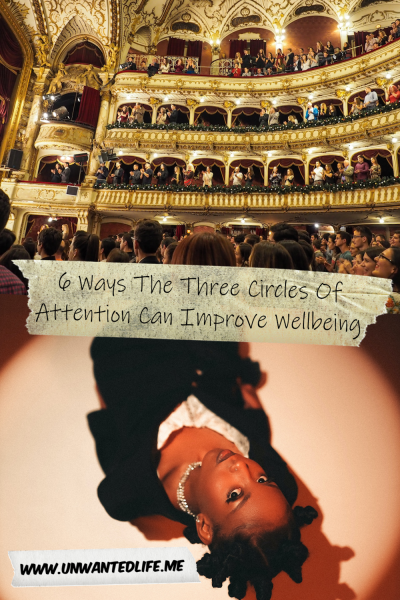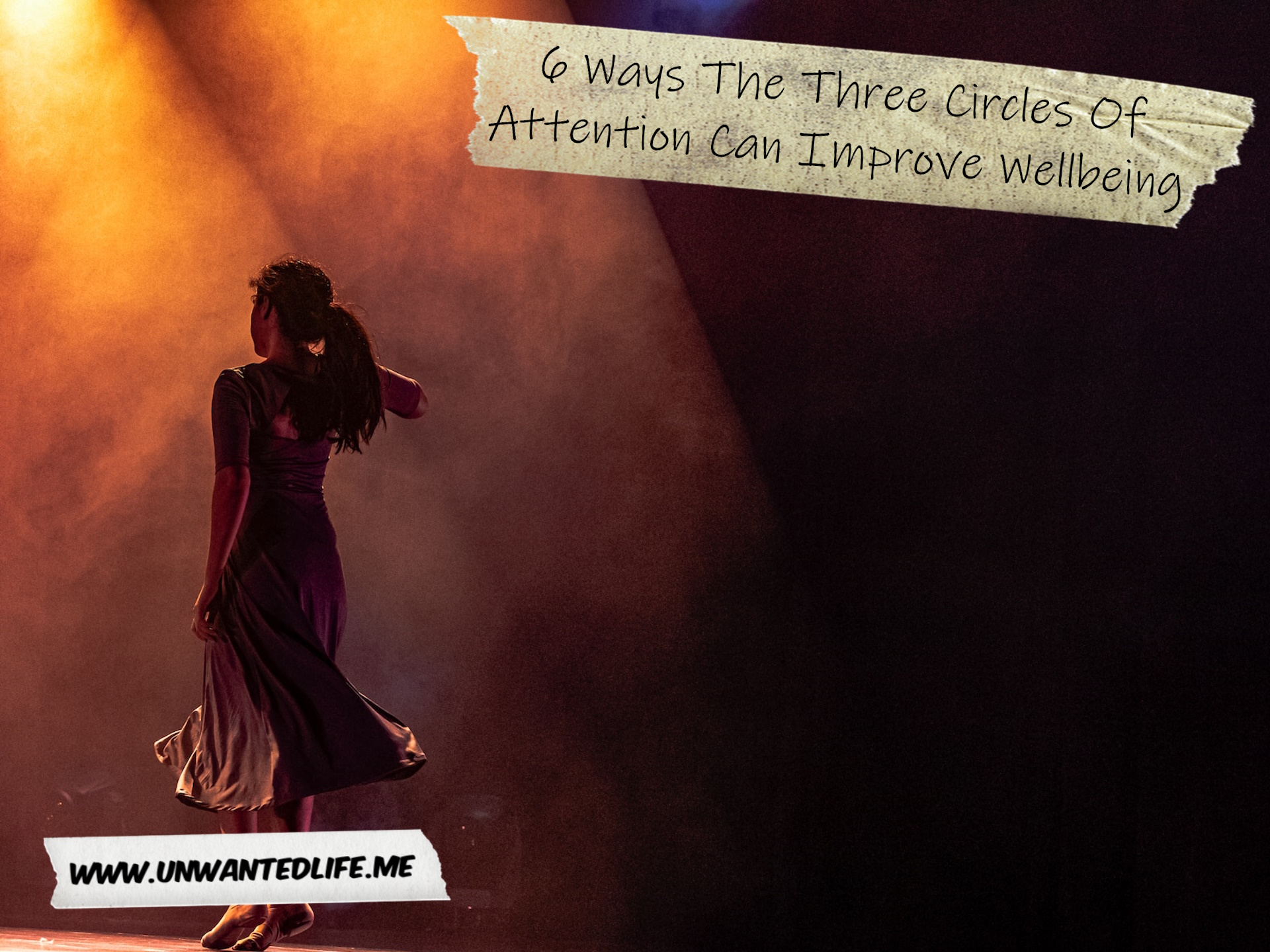Life is complex and our experiences affect each of us differently. One way we can manage our life is to think of it is through the concept of circles of attention. This concept suggests that the amount and type of attention we pay to certain aspects of our lives can have a direct effect on our mental health. By understanding what these circles encompass, we can gain insight into how to better manage our mental health and wellbeing.
What Are The Three Circles Of Attention?
The three circles of attention were created by Konstantin Stanislavski, a Russian theatre director whose system became the foundation of modern ‘method acting‘ (Theatre Workout). Stanislavski believed that actors needed a sense of isolation to better inhabit their characters to help them concentrate on themselves (BBC Bitesize). This is done to help actors avoid paying attention to what other people might think about them as they perform.
First circle
The first circle of attention is referred to as ‘Solitude in Public’ (BBC Bitesize). In this circle, it’s all about the actor as a single entity, no matter where they are or what they’re doing. The actor imagines they’re alone, even if they’re crammed into a London tube carriage during rush hour (Drama & Theatre).
Second circle
In the second circle, the actor might show awareness of other characters, such as the ones they’re addressing (BBC Bitesize). Drama & Theatre says this circle is where you’ll engage in conversation with one or two people, where the actors’ energy will be focused on those one or two people and nowhere else.
Third circle
The third and final circle is the most energy-demanding circle. This is because the whole world is now your stage and you have to engage the audience, so it feels like you’re talking to every audience member. But it’s not about what you say, but how you say it (Drama & Theatre).
Acting Skills And Mental Wellbeing
The three circles of attention refer to the idea that there are certain areas in life which require more focus than others. By recognising these areas, we can better allocate our time and energy towards them in order to achieve better results. It also helps us identify potential triggers which can cause us stress or anxiety so that we can take steps to avoid them or manage them better.
By understanding circles of attention, we can become more mindful about how we spend our time and prioritise what matters most in life. This will ultimately help us lead a healthier and happier life with improved mental health.
This makes the concept of circles of attention an important one when it comes to mental health. That’s because it refers to the idea that we can become overwhelmed if we are focusing on too many things at once, leading to those feelings of stress and anxiety. By focusing our attention on just one or two tasks at a time, we can create a sense of calm and clarity. This allows us to prioritise our tasks more effectively and reduce the risk of burnout.
Therefore, the three circles of attention can be used to manage our mental health and help us stay productive while avoiding feeling overwhelmed. They will also help us focus on what matters the most to us when applied to our wellbeing.
Applying The Three Circles Of Attention
There are two ways I believe you can apply the three circles of attention to aid our mental health. The first is to take a more direct approach to applying the circles of attention to your life. The second way is how you can form your own circles of attention around the things that matter to your wellbeing.
Examples of the direct approach to the circles of attention are:
Carefree
One of the best lessons from the three circles of attention is how it teaches you to not pay attention to what other people might think about you, so you can live in the moment. No matter where you are or what you’re doing, if you apply the first circle to your life, you will only care about what you think of yourself. Because it doesn’t matter what others think of you, and worrying about that will affect how you perform and live your life.
Safe space
By applying the second circle of attention to how you interact with the people around you, especially your loved ones, you can make them feel like they have your attention. Everyone likes to feel like they have the attention of the people they’re with, which makes it easier to be a safe space for others and makes people feel valued and important.
This can be especially beneficial when it comes to your partner and children. So arrange date nights with your partner so you can have each other’s complete attention, and stop looking at your phone when you’re out. When you’re doing something with your kids, be fully present with them. Basically, apply mindfulness thinking to your relationships.

Examples of creating your own circles of attention:
Prioritising self-care
By creating a circle of attention focused on self-care, you can identify the activities, hobbies, and practices that are most important for your wellbeing, such as exercise, meditation, or spending time with loved ones. Using the circles of attention can help us prioritise self-care and make it a regular part of our routine, which will hopefully lead to the formation of a habit.
Managing stress
Creating a circle of attention around stress management can help you identify the sources of stress in your life and develop strategies for coping with stress, such as deep breathing or progressive muscle relaxation. This can help reduce the negative impact of stress on our mental and physical health.
Setting goals
Creating a circle of attention focused on goal-setting can help you identify your values and aspirations and develop a plan for achieving them. This can help increase your sense of purpose and fulfilment in life, and promote a greater sense of wellbeing.
Cultivating positive relationships
By creating a circle of attention focused on relationships, you can identify the people in your life who are most important to you and make an effort to nurture those relationships. This can help you feel more connected and supported, which can improve your overall wellbeing.
Summary
Overall, circles of attention can be a powerful tool for improving wellbeing by helping you focus your attention on what matters most to you, and take action to promote your own wellbeing and happiness. So, why not take a leaf out of what actors learn in drama school and apply it to your life so you can focus on the things that matter?
As always, leave your feedback in the comments section below. Also, please share your experiences with focusing on the things that matter and using the three circles of attention in the comments section below as well. Don’t forget, if you want to stay up-to-date with my blog, then sign up for my newsletter below. Alternatively, get push notifications for new articles by clicking the red bell icon in the bottom right corner.
Lastly, if you’d like to support my blog, you can make a donation of any size below. Until next time, Unwanted Life readers.


I enjoyed reading your article about 6 ways the three circles of attention can improve wellbeing. You have shared some valuable and helpful insights on how to use the three circles of attention as a mindfulness technique and a coping strategy. I liked how you explained the concept and the features of the three circles of attention, as well as the benefits and examples of using them in different situations. You have also given me some inspiration and motivation to try the three circles of attention for myself or for others. You have made me want to learn more about the three circles of attention!
Thank you for sharing your thoughts
This is the first time I heard of 3 circles of attention. It’s interesting. Thank you for sharing.
Thanks for commenting
This is very true and something. I actually learned something new from this post. Thank you for sharing!
It seems like you stopped saying something mid sentence
I have been reading a lot about mindfulness lately. There is a lot to be said for it,
Thanks for commenting
I never knew that the Three Circles of Attention originated from Konstantin Stanislavski’s method acting system, where actors use solitude in public as the first circle to focus on themselves, the second circle to engage with a few people, and the third circle to address the entire audience. This technique seems remarkably applicable beyond the stage, offering valuable insights into enhancing our focus, empathy, and authenticity in everyday interactions. I’m intrigued to experiment with these circles in my own life and see how they can positively impact my connections with others and overall wellbeing. Thank you for sharing this enlightening information; I look forward to exploring more about Stanislavski’s techniques and their practical applications.
Thank you for sharing your thoughts. I hope you find this approach useful